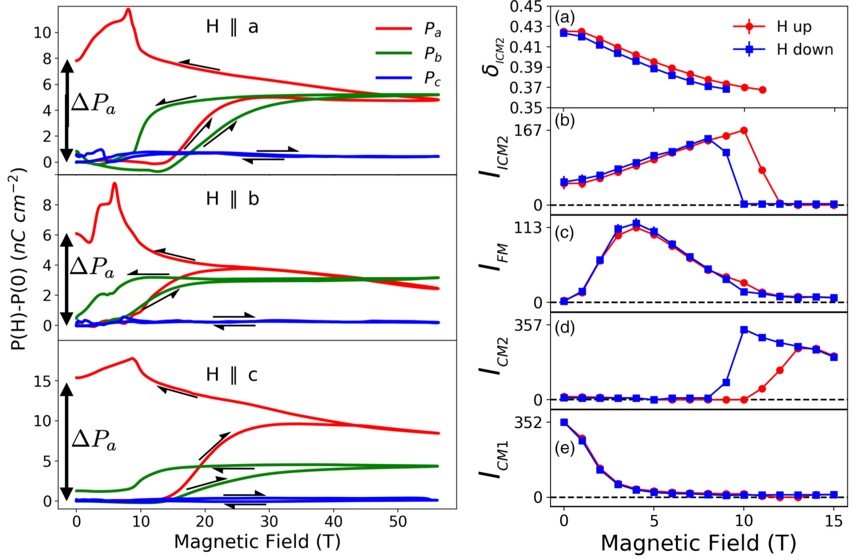V. Balédent1, A. Vaunat1,2,3, S. Petit3, L. Nataf2, S. Chattopadhyay4,5, S. Raymond6, and P. Foury-Leylekian1
1Université Paris-Saclay, CNRS, Laboratoire de Physique des Solides, 91405 Orsay, France
2Synchrotron SOLEIL, L’Orme des Merisiers, Saint Aubin BP 48, 91192 Gif-sur-Yvette, France
3Laboratoire Léon Brillouin, CEA, CNRS, Université Paris-Saclay, 91191 Gif sur Yvette, France
4Dresden High Magnetic Field Laboratory (HLD-EMFL), Helmholtz-Zentrum Dresden-Rossendorf, 01328 Dresden, Germany
5UGC-DAE Consortium for Scientific Research Mumbai Centre, 246-C CFB, BARC Campus, Mumbai 400085, India
6Université Grenoble Alpes, CEA, IRIG, MEM, MDN, 38000 Grenoble, France
Electronic ground-state hysteresis under magnetic field in GdMn2O5, Physical Review B 108, 104419 (2023).
Multiferroic compounds have been extensively investigated due to their simultaneous manifestation of ferroelectricity and magnetic order. In certain compounds like the RMn2O5 family, the coupling is sufficiently robust to manipulate ferroelectric properties through the application of a magnetic field. The potential applications of such compounds are diverse, ranging from information storage with 4-state memories to the energy optimization of data writing. A notable illustration of this coupling is evident in the GdMn2O5 compound, where the electrical polarization undergoes reversal under the influence of a static magnetic field measuring 2 Tesla.
Our recent experimental results, combining measurements of electrical polarization and inelastic neutron scattering under magnetic field, have revealed a previously unknown effect linked to this magneto-electric coupling. Neutron scattering measurements on the IN12 3-axis spectrometer (CRG-ILL) first revealed a complex magnetic phase diagram as function of temperature and magnetic field. A key element of this diagram is the transition to a new magnetic state above 11 Tesla at low temperature. These exhaustive measurements both while increasing and decreasing the magnetic field indicate that the magnetic order returns to its initial state once the field drops back to 0 Tesla.
In terms of ferroelectric properties, a change in electrical polarization could be expected at the 11 Tesla transition, but two additional unexpected results were observed. Firstly, the new magnetic phase shows polarization in the a direction, contrary to all measurements carried out on all members of the RMn2O5 family (along the b direction). Secondly, the electrical polarization does not return to its initial state once the magnetic field is lowered to 0 Tesla, contrary to what neutron scattering has shown for magnetism. The observation of a remanent electric polarization following a magnetic field sweep is exciting: not only is it possible to access new fundamental states, but also introduces the notion of path-dependent ground state.

Left : Variation of the electric polarization at T=2K along a, b, and c with respect to zero-field initial state as a function of increasing and decreasing magnetic field. Right : Evolution as a function of the magnetic field along the b axis and T=2K of the magnetic peaks measured by neutron scattering : (a) and (b) position and intensity of the incommensurate phase, (c) intensity of the ferromagnetic component, (d) the intensity of another field induced incommensurate phase and (e) the intensity of the commensurate low field phase.







